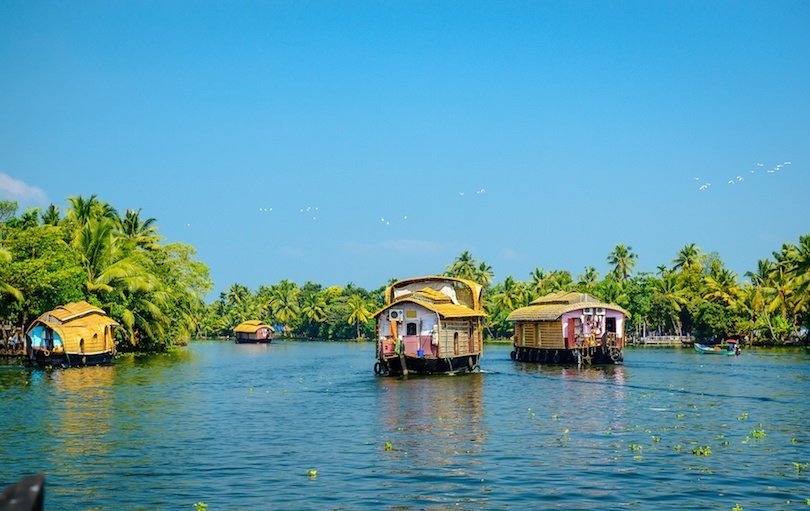As a result of the decreased cost of flying, many people are spending a significant amount of money on vacations. After that, it doesn’t matter how much money you spend on seeing these landmarks because it won’t be worth it. Visitors to India must pay an entrance charge to more than one hundred different monuments.
Tourists from other countries typically rack up two to three times higher tabs. Travelers from all over the world usually travel in large groups when they visit destinations like India and other countries. When significant numbers of people see a monument, the monument’s owners and operators make a lot of money. The revenues collected in entry fees provide the Indian government with a significant amount of income each year.
1. Taj Mahal
In memory of his late wife Mumtaz, Shah Jahan commissioned the construction of the Taj Mahal, which is now considered to be one of the seven wonders of the modern world. The tomb of Mumtaz is significantly more well-known than this location. Shah Jahan had chosen the Yamuna River as the gravesite because he believed it to be the most strategically advantageous. The monument’s construction took place over 22 years, and it is today the most visited tourist destination in India.
In addition to tourists coming from India, many travelers are coming from other nations. As a direct consequence of this, the Indian government can enjoy the benefits.
2. Red Fort
In the year 1638, Shah Jahan, who served as the Mughal emperor of India, had the Red Fort built as a stronghold for defensive purposes. After some time during which it was unconquerable, the fort was eventually taken by British and Sikh forces. UNESCO has given it the title of World Heritage Site. People come from all over the world to see the Chandni Chowk Fort, a well-known and renowned tourist attraction.
3. Qutub Minar
An outstanding example of Indo-Islamic architecture can be found in Delhi, India, at the Qutub Minar. It’s the world’s highest minaret. According to historical documents, it is believed that the construction of the fort began in the 13th century under the leadership of Qutb-ud-din Aibak, the founder of the Delhi Sultanate. The Minar can be found in the Mehrauli neighborhood of Delhi. This is the most historic and affluent neighborhood in the entire city.
4. Humayun’s Tomb
In the year 1570, the mortal remains of Humayun, the second Mughal emperor, were laid to rest inside this mausoleum. The Taj Mahal was conceptualized after being influenced by this famous building. A garden is included here in addition to the structure itself. Many individuals assemble at this location in the evening to shoot photographs and enjoy a picnic.
5. Agra Fort
Even though it is not quite as widely known as the Taj Mahal, visitors to Agra are strongly encouraged to see the Agra Fort. The Rajput dynasty was responsible for constructing this brick fort, but the Mughals eventually took possession of it. After some time had passed, the fort was restored in the style of Mughal architecture. When Akbar moved his capital to Agra, he chose to reside in the Agra Fort during his reign. Such an alluring landmark is very beneficial to the tourism industry.
6. Fatehpur Sikri
Fatehpur Sikri is now an uninhabited town; yet, during the Mughal Emperor Akbar, it functioned as a great metropolis and was one of the most important cities in the region. Despite this, it continues to be a popular place to go for tourists who are just in Agra for the day. It is approximately 40 kilometers away from Agra, the closest major city.
7. Khajuraho
The most well-known aspect of Khajuraho is the sexually suggestive engravings that can be found on the temple walls. The name of the city Khajuraho comes from the word khajura, which translates to “date palm.” Khajuraho is located in the northern part of the state of Madhya Pradesh. Up until the 1850s, the temple of Khajuraho was mainly disregarded for several decades. Khajuraho is home to several well-known tourist destinations, including Panna National Park and the Matangeshwar Shiva Festival.
8. Ajanta and Ellora Caves
The vast majority of these tunnels were created by kind and noble rulers between the second and eleventh centuries after the Common Era. Ellora is home to 34 caverns or viharas carved out between the sixth and eleventh centuries of the Common Era. At Ajanta, located approximately 99 kilometers north of Aurangabad, 29 caverns were explicitly designed to be used as a place of residence by Buddhist monks.
Although it is located 15 kilometers to the west of Aurangabad, Ellora is home to many religious landmarks. These include Buddhist, Hindu, and Jain sites. It is possible to discover the Kailash Temple at Ellora Caves, the largest single-stone structure globally. Mumbai is 400 kilometers away from Aurangabad.
9. Sun Temple, Konark
The Sun Temple at Konark, India, was constructed in the Kalinga architectural style during the 13th century and is often considered the most beautiful and well-known sun temple in all of India.
The temple is designed in the form of a chariot, giving it its characteristic appearance. This symbolizes the celestial chariot, which is pulled by seven horses and ridden by Arun, who is both the son of Sage Kashyap and the Sun God. This sanctuary, located in Odisha and 35 kilometers away from Puri, is a part of the “golden triangle” that includes Bhubaneshwar and Puri.
10. Mahabalipuram
Another popular attraction in Mahabalipuram is the Shore Temple, which comprises three spectacular granite temples and is located along the city’s waterfront. After the strong demon king, Bali was commanded by Lord Vamana, an incarnation of Mahavishnu, to rule the netherworld and leave behind his supremacy over the earth. The city was given the name Bali in honor of him. The distance to Pondicherry is 95 kilometers.
